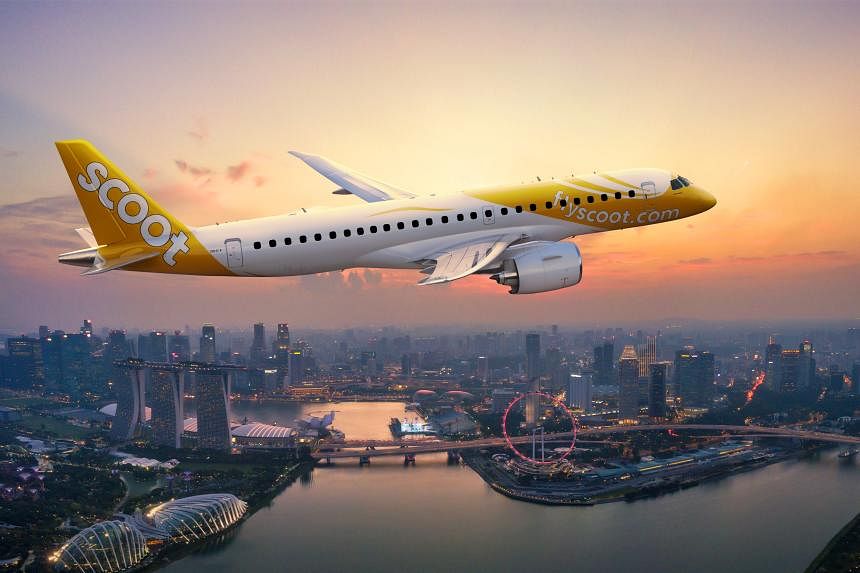SINGAPORE - Low-cost carrier Scoot will add three to five more new destinations in South-east Asia to its growing network in the coming year, with its new fleet of Embraer E190-E2 planes serving these additional spots.
These would be in addition to Koh Samui in Thailand and Sibu in Sarawak, Malaysia – two new destinations that Scoot said on March 5 will be served by the 112-seat single-aisle planes, to be delivered to the airline over two years, starting in April.
Four other existing Scoot destinations – Hat Yai and Krabi in Thailand, and Kuantan and Miri in Malaysia – will also be served by the new Embraer jets, with some flights starting in May and the rest in June, said the airline, which is wholly owned by Singapore Airlines.
In an interview on March 7, Scoot chief executive Leslie Thng said the carrier wants to continue growing its capacity, which it measures by the number of available seats for passengers multiplied by the distance flown.
In January 2024, Scoot had a capacity of 3.297 billion available seat-km compared with 3.347 billion in January 2020 – representing a 98.5 per cent recovery from pre-Covid-19 levels.
Its nine new Embraers, which are leased from American firm Azorra, will provide the platform for growth, said Mr Thng. Scoot carried about 15.4 million passengers in 2023.
“There are still a lot of options within this region, including Indonesia, Vietnam and the Philippines... We are still trying to finalise some of the details,” Mr Thng added.
Scoot’s new routes to Koh Samui and Sibu will increase its network to 69 destinations, which include cities in Indonesia, Vietnam and the Philippines.
Mr Thng said there are no plans yet to add new destinations for its Airbus A320s and Boeing 787s, but in 2025, Scoot will begin to add 18 new narrow-body planes – a mix of A320neos and A321neos – to its fleet.
When that happens, the airline will be able to look for new destinations for the new aircraft, or to upgrade existing routes with larger aircraft as travel demand matures, he added.
Currently, Scoot has a fleet of 54 aircraft – 18 A320ceos, six A320neos, nine A321neos and 21 Boeing 787s.
Mr Thng said there are no immediate plans to fly the new Embraer jets, which have a range of about five hours, to China, but the new Embraer destinations in South-east Asia will provide more options to Chinese tourists for connections via Singapore.
He said China continues to be an important market, and Scoot is currently operating at about 80 per cent of its pre-Covid-19 flight capacity, with plans to go back to 100 per cent as soon as possible.
However, this will still depend on the travel demand.
Mr Thng noted an increasing trend of individuals and smaller groups of travellers visiting Singapore and South-east Asia from China, and Scoot is adapting its marketing and sales strategies to engage these customers, for instance by tapping Chinese social media platforms like Xiaohongshu.
The airline is also working to improve its on-time performance, which is currently in the mid-70 per cent range for flights out of Singapore, Mr Thng added. Pre-Covid-19, this was in the high 70s.
To cater to rising travel demand, Scoot has upped its recruitment, hiring slightly more than 500 workers over the past 12 months, mainly cabin crew, but also pilots and office workers such as IT professionals.
Supply chain issues remain a challenge, with the airline industry facing delays in the delivery of new planes and spare parts. Mr Thng said three of Scoot’s A320neos are also currently grounded due to manufacturing flaws in their Pratt & Whitney engines, up from two previously.
He said the airline has extended its leases on a number of its A320ceos to mitigate the impact of this.
Looking ahead, Mr Thng said travel demand in the next three months remains robust. He added: “We have been profitable, and we are still profitable up to December.”
Independent aviation analyst Brendan Sobie of Sobie Aviation said he would like to see the E190-E2s succeed at Scoot, as the plane is an appealing aircraft for passengers, with no middle seats, and it also facilitates new routes for the carrier.
However, Mr Sobie said the economics of Scoot’s initial E190-E2 routes, except for Koh Samui, are challenging because they are price-sensitive markets. As Scoot would be able to return its nine Embraer jets after four years, it is a low-risk experiment, he added.
Asked whether the Embraer jets will be a long-term fixture for Scoot, Mr Thng said the airline is taking a “midterm view” on the new plane. He said the business case for the Embraers was strong enough, despite the risks of Scoot operating a completely new aircraft type and the unknowns of launching flights to new places.
“(By 2025), we would have a good picture of how we can effectively deploy the planes... to take a longer-term perspective,” he added.


